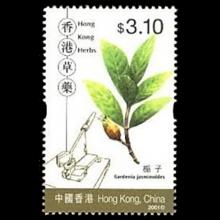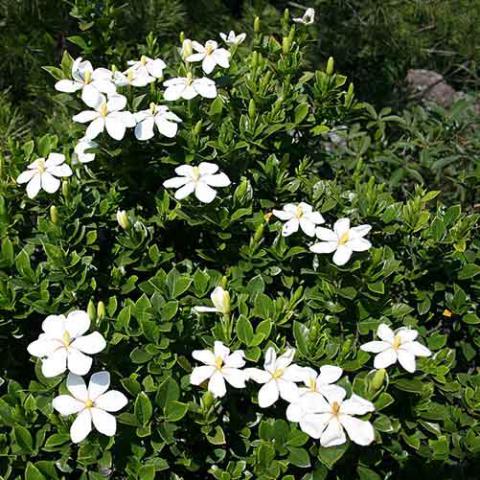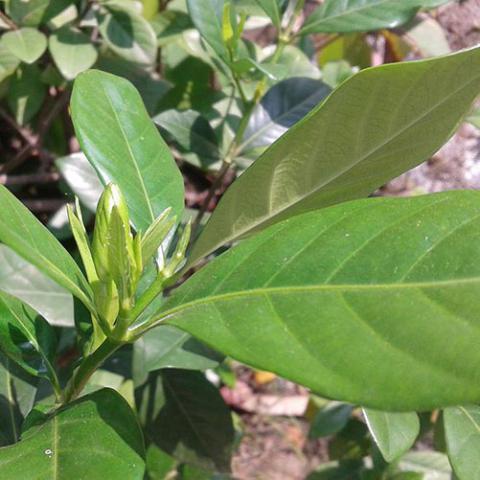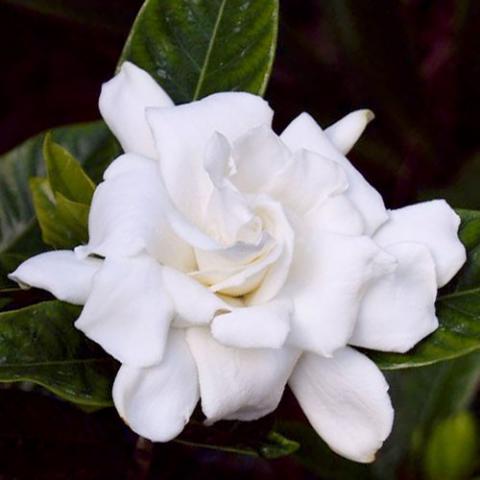NAME(S)
TAXONOMY
PLANTAE ID
THERAPEUTIC
Hong Kong
Issued:
Stamp:
Gardenia jasminoides
Hong Kong
Issued:
Stamp:
Gardenia jasminoides
Hong Kong
Issued:
Stamp:
Gardenia jasminoides
Genus species (Plantae): Gardenia jasminoides
Gardenia jasminoides, commonly known as gardenia, is an evergreen flowering plant of the coffee family Rubiaceae. It originated in Asia and is most commonly found growing wild in Vietnam, Southern China, Korea, Taiwan, Japan, Myanmar, India and Bangladesh. Wild plants range from 30 cm to 3 m high and have a rounded habit with very dense branches with opposite leaves, lanceolate-oblong, leathery or gathered in groups on the same node and by a dark green, shiny and slightly waxy surface and prominent veins.
With its shiny green leaves and heavily fragrant white summer flowers, it is widely used in gardens in warm temperate and subtropical climates, and as a houseplant in temperate regions. It has been in cultivation in China for at least a thousand years, and was introduced to English gardens in the mid-18th century. Many varieties have been bred for horticulture, with low-growing, and large, and long-flowering forms.
History
Evidence of G. jasminoides in cultivation in China dates to the Song Dynasty (960-1279 AD), where both wild and double-flowered forms have been depicted in paintings, such as those of the Song Emperor Huizong, and the Tenth century artist Xu Xi. The Yuan Dynasty (1271–1368) saw it on lacquerware, and the Ming Dynasty on porcelain (1368–1644). In 1794, English statesman Sir John Barrow saw gardenias in nurseries in Guangzhou, China.
Daniel Solander reported that the species was brought to the United Kingdom in 1744 on the Godolphin by captain Hutchenson, who gave it to botanist Richard Warner of Woodford Row, Essex. Warner, however, was unable to propagate it until the botanist John Ellis recommended James Gordon, a gardener at Mile End. Gordon was successful in August 1757, and plants sold well thereafter; each cutting-grown plant fetching five guineas.
Gardenias were first grown in the United States in 1762, in the Charleston garden of Alexander Garden, who had moved there 10 years previously.
Taxonomy and naming
Gardenia jasminoides was described by English botanist Ellis in 1761, who realized on dissecting the flower that it was not closely related to jasmine and warranted a new genus. He initially proposed Warneria after the original plant's owner in England. However, Warner declined to have it named for him and so Ellis chose Gardenia to honour Garden. It gained its association with the name jasmine as the botanist and artist Georg Dionysius Ehret had depicted it and queried whether it was a jasmine as the flowers resembled the latter plant. The name stuck and lived on as common name and scientific epithet.
The name G. augusta of Linnaeus has been ruled invalid.
The common names cape jasmine and cape jessamine derive from the earlier belief that the flower originated in Cape of Good Hope, South Africa. Other common names include danh-danh and jasmin.
Description
Gardenia jasminoides is a shrub that ranges from 30 cm to 3 meters (1-10 ft) high in the wild, with cylindrical to flat branches that are furry at first becoming smooth. The leaves are arranged oppositely—or rarely in groups of three—along the branches. They are either subsessile or on short 0.5-1 cm long petioles. The leaves themselves are 3-25 cm long by 1.5-8 cm wide and can be oblong-lanceolate, obovate-oblong, obovate, oblanceolate, or elliptic in shape. Their upper surface is smooth and shiny, or slightly furry along the primary veins, while the undersurface is slightly furry to smooth. Each leaf has 8 to 15 pairs of secondary veins. The flowers are solitary and terminal (arising from the ends of stems).
The white flowers have a matte texture, in contrast to the glossy leaves. They gradually take on a creamy yellow color and a waxy surface. They can be quite large, up to 10 cm (4 in) in diameter, loosely funnel-shaped, and double in form. Blooming in summer and autumn, they are among the most strongly fragrant of all flowers. They are followed by small, oval fruit.
Uses
Polynesian people in the Pacific islands use the fragrant blooms in their flower necklaces, which are called Ei in the Cook Islands, Hei in French Polynesia and Lei in Hawaii. Gardenia flowers can be eaten raw, pickled, or preserved in honey.
Gardenia jasminoides fructus (fruit) is used within traditional Chinese medicine to "drain fire" and treat certain febrile conditions, i.e. have an anti-inflammatory and antipyretic effect.
Shishihakuhito is a Chinese herbal medicine mainly composed of gardenia fruit, used to treat atopic dermatitis as it inhibits IgE-mediated histamine release. In 2020, the case of a woman who had developed blue-gray discoloration of the skin as a result of chronic intake of gardenia fruit extract was published.
Chemistry
The iridoids genipin and geniposidic acid can be found in G. jasminoides fruit.
Crocetin (a chemical compound usually obtained from Crocus sativus) can also be obtained from the fruit of G. jasminoides. The fruit has crocin which is used as a yellow dye, which is used for clothes and food.
Reference: Wikipedia




